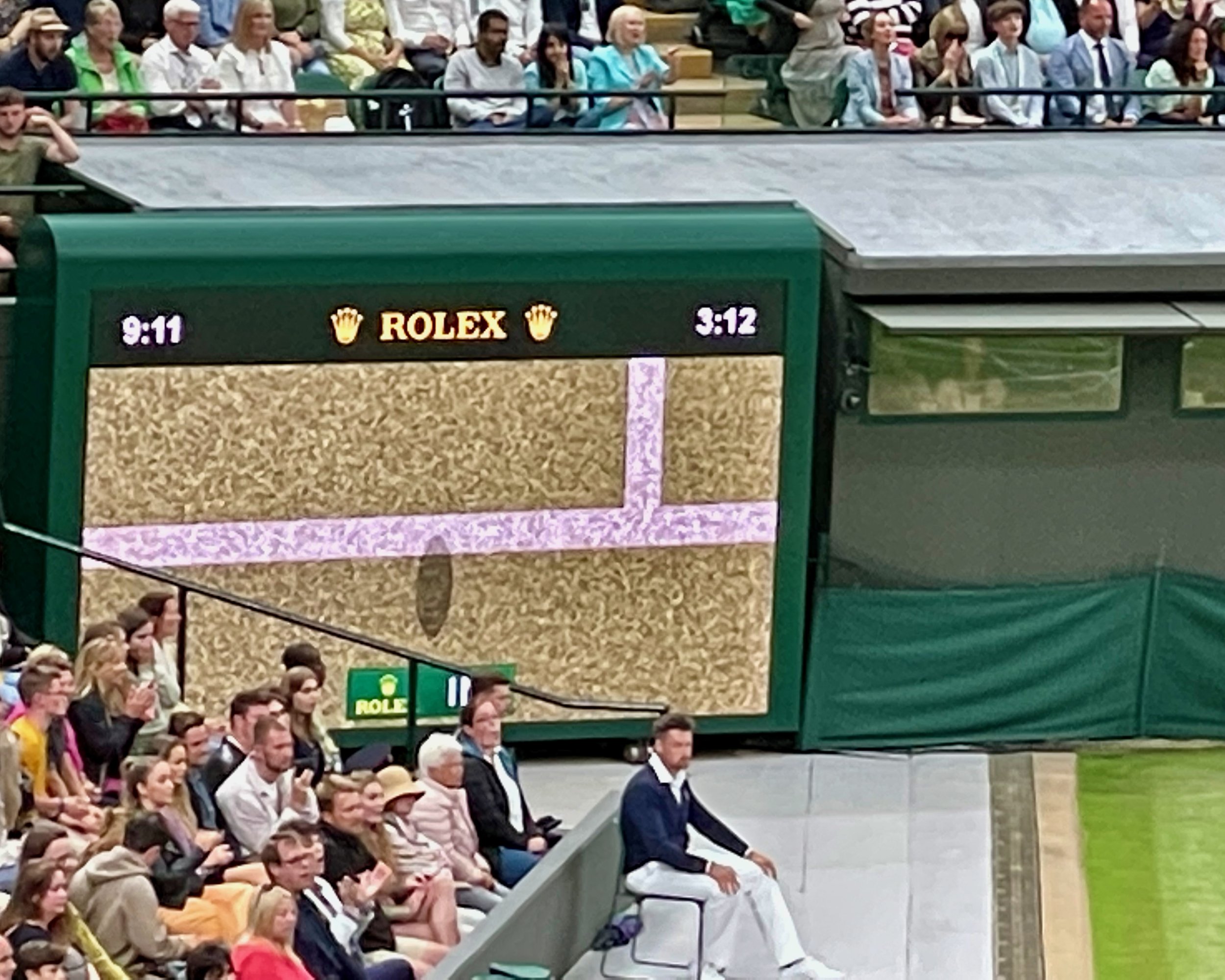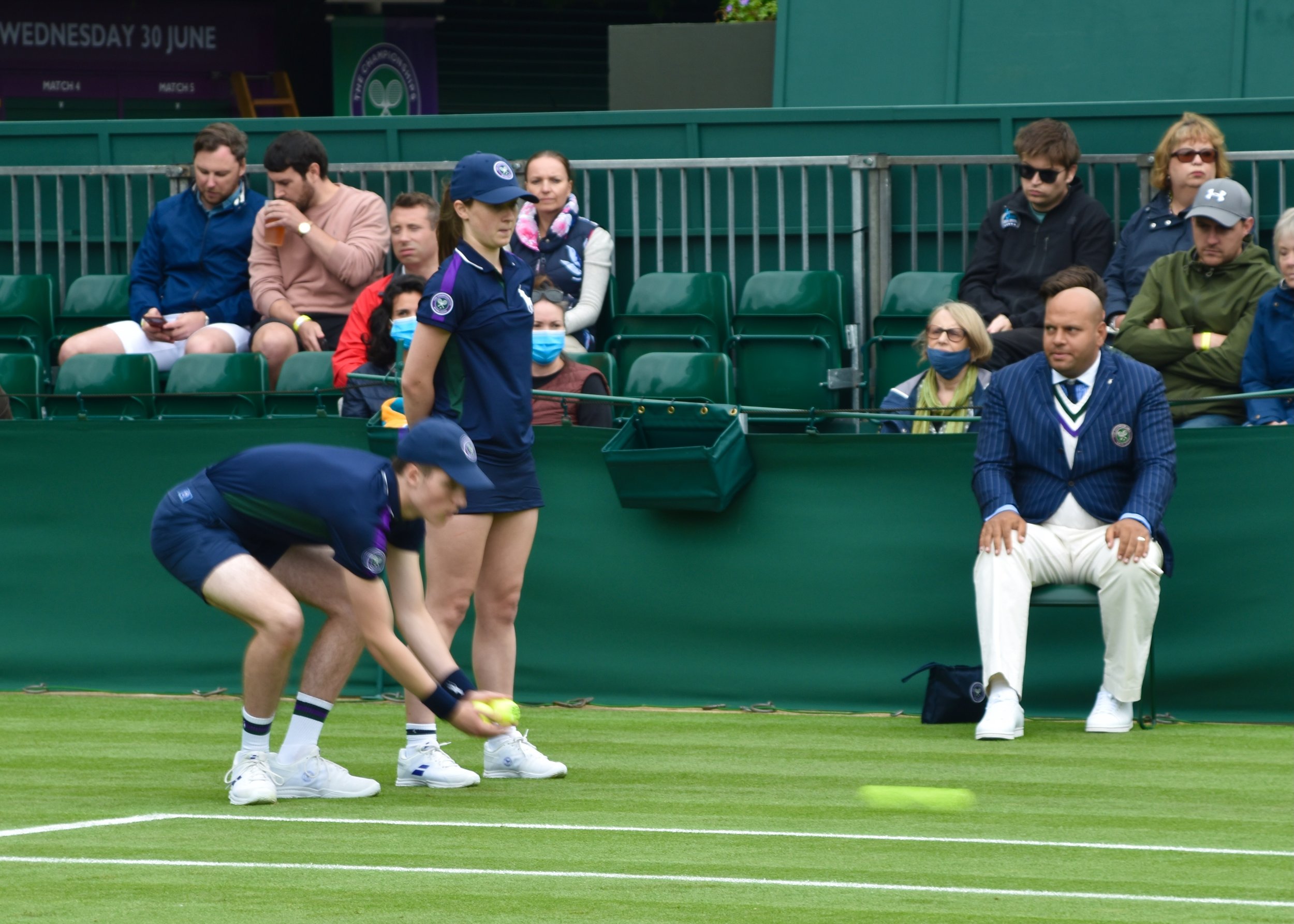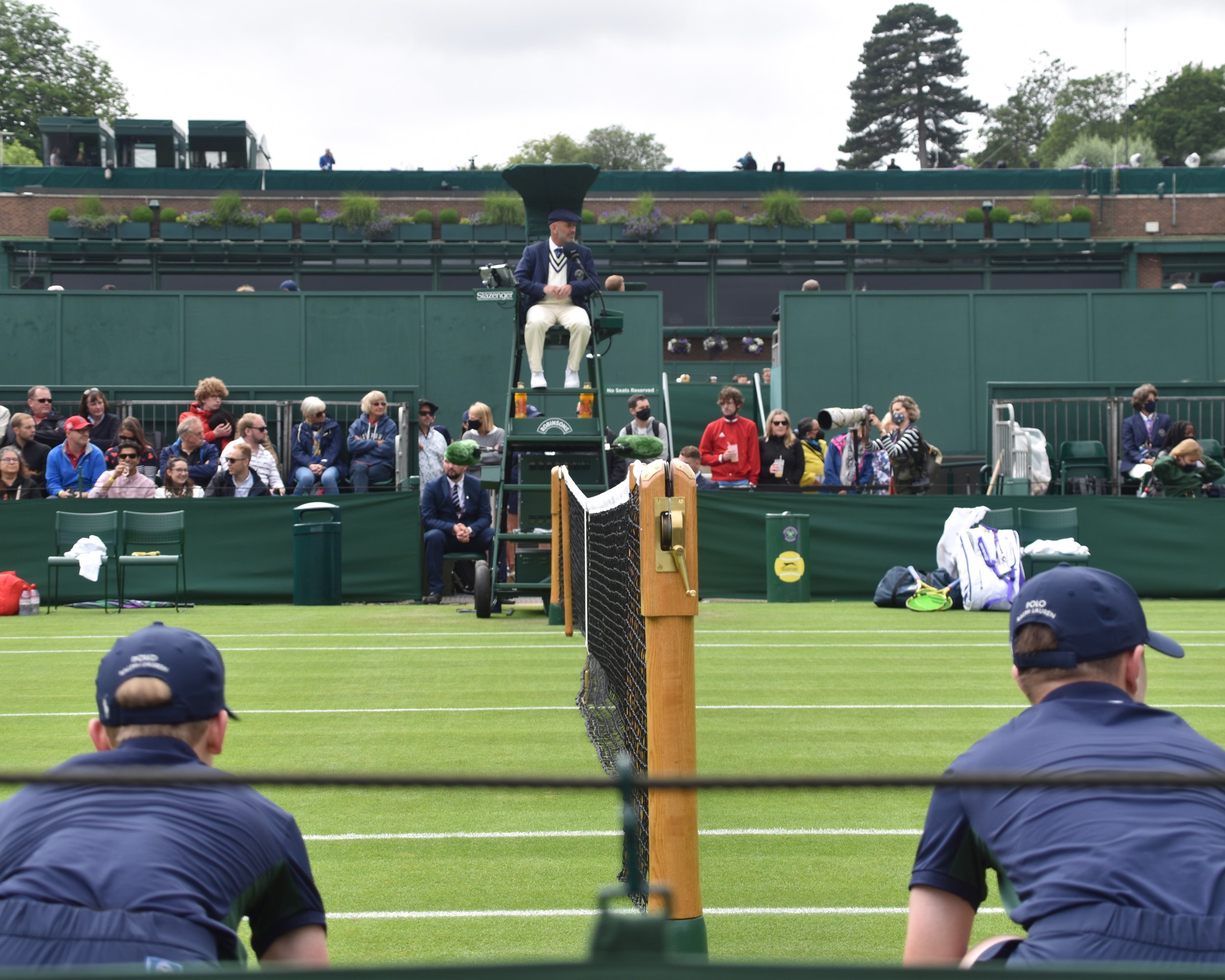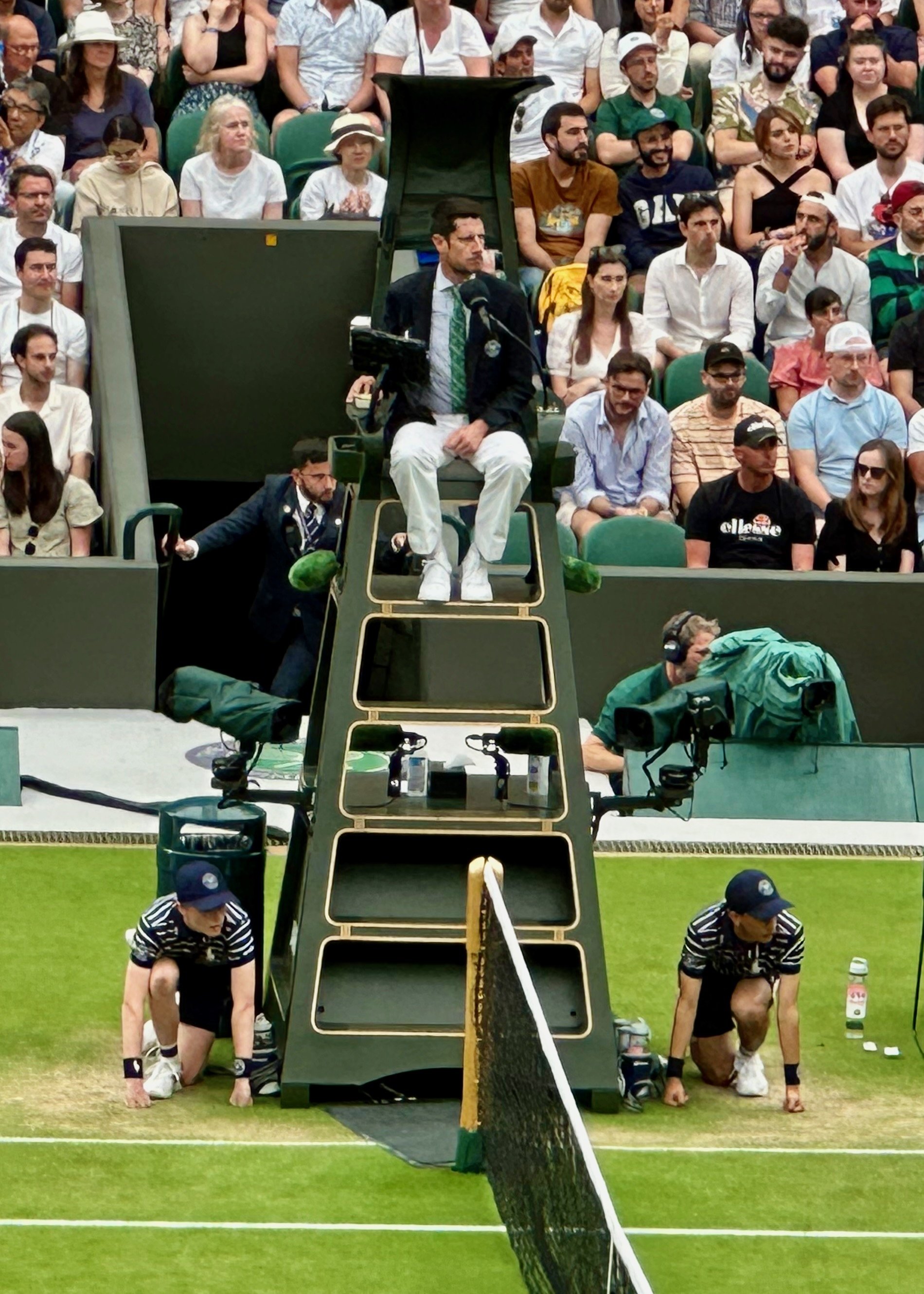The New York Times suggests computers, not people should call lines. How can Cyclops possibly interpret the other essential rules of tennis.
Two days after the midpoint of the Wimbledon fortnight — following a weekend of a few questionable line calls — the New York Times wrote “At Wimbledon, the Human Eye Keeps Dropping the Ball,” questioning the legitimacy of line judges at Wimbledon. It argued that perhaps Hawk-Eye Live, an electronic line calling system, could have saved several players their matches, including Andy Murray, Bianca Andreescu and Venus Williams, among others. True, the technology of Hawk-Eye, which uses cameras to capture the bounce of every ball from multiple angles analyses the images to depict the ball’s trajectory and impact points, does leave a fairly small margin of error (unless the situation is clay, in which the ball leaves a mark). But how much does the computer really know about the other aspects of line judging — or the rules of tennis for that matter — or how to apply the rules in certain situations.
Test your knowledge in 25 questions of the court, the code violations and tennis’ other strange conditions without an open book, on the first try and with a ninety percent pass rate, and we’ll find you some officials’ swag. Don’t pass, and you’ll get a full-length recording of the irritating computerized and strangely child-like voice calling “out” twenty times for your listening pleasure.
THE COURT
1. How long is a regulation tennis court?
a) 75 feet
b) 73 feet
c) 78 feet
d) 80 feet
2. How wide is a regulation singles court?
a) 27 feet
b) 25 feet
c) 30 feet
d) 28 feet
3. How high is the centre net?
a) 3 feet
b) 3.5 feet
c) 4 feet
d) 3.25 feet
4. For singles matches, if a doubles net is used, then the net is supported by two “singles sticks,” each of which is how high?
a) 3 feet
b) 3.5 feet
c) 4 feet
d) 3.25 feet
5. Other than the centre service line and centre mark, which is two inches, the other lines of the court are how wide?
a) 2 inches
b) 2.5 inches
c) between 1 and 3 inches
d) between 1.5 and 3.5 inches
6. How wide is the baseline?
a) 2 inches
b) 2.5 inches
c) between 1 and 3 inches
d) between 1 and 4 inches
THE BALL
7. Which colour of balls are allowed for official use in ITF-sanctioned tournaments?
a) yellow only
b) white and yellow
c) choice of the tournament director
e) white only
8. How many balls are used during a professional match?
a) One can of four
b) Two cans of three
c) Three cans of three
d) One can of three
9. What happens if a ball gets broken during play?
a) the player hitting the winning shot wins the point
b) play is stopped and the ball is replaced immediately; the point is replayed
c) play continues until the ball disintegrates
d) the player hitting the winning shot loses the point because he destroyed the ball
10. What happens if a ball goes soft during play?
a) play is stopped and the ball is replaced immediately; the point is replayed
b) play continues until the ball can be replaced; all shots stand
c) the player who discovers the soft ball and stops the point wins the point
d) the player who discovers the soft ball and stops the point loses the point
11. When do the players receive new balls during a professional match?
a) after the first set, the second set, and every subsequent set
b) after the first nine games and thereafter, every seventh game
c) after the first seven games and thereafter, every ninth game
d) during every fifth change of ends
PLAYER CONDUCT
12. If a player wearing a cap returns a ball and the cap falls off during the point causing a distraction, their opponent receives:
a) the point
b) a let with first serve
c) point replay
d) tough luck
13. If an returner hits a ball and it clips the net between the singles stick and the net post and lands in his opponent’s singles court, the ball is:
a) good and still in play
b) out
c) to be replayed
d) a let and first serve
14. If a player one a grass courts takes her racquet and deliberately swats the grass or hits the ground, she receives:
a) applause
b) an automatic code violation warning for hitting a live object
c) an automatic point penalty for hitting a live object
d) a reprimand from the chair umpire
15. If it starts to rain and a 15-minute rain delay is called, when the players return to court, how long does their warm-up last?
a) no warm-up, return to play
b) a full five-minute warm-up
c) serves only
d) a three-minute warm-up
16. “Gamesmanship” or “unsportsmanlike behavior” can be called for which of the following?
a) bouncing the ball past the allotted service time
b) making a gesture while approaching the net
c) taking a long bathroom break
d) all of the above
17. Players receive how much time for a change of ends?
a) 180 seconds
b) 120 seconds
c) 60 seconds
d) 90 seconds
18. How many challenges to a “wrong” call does each player receiver per set?
a) five
b) three
c) unlimited
d) three, plus one additional if match goes to a tiebreak
OFFICIAL CONDUCT
19. If a player challenges a call and not satisfied with the chair umpire’s ruling, calls the match referee, who has the final say?
a) the referee
b) the tournament director
c) VAT
d) the chair umpire
20. If a line judge wants to call the ball “in” during a tight point, he:
a) points his hand in the direction the ball landed
b) points his arms down, fingers touching at tips
c) shouts “in”
d) places his foot in the direction in which the ball lands
21. A ball is deemed “in” as long as…?
a) the ball comes within one inch of the line, inside or outside of it
b) any part of the ball touches any part of the line
c) the ball falls squarely on the line
d) the ball falls in the court without touching the line
22. On clay, when can a ball mark inspection be made?
a) when a player requests it at any point
b) when the chair umpire cannot determine the call with certainty
c) when the line judge has not seen the ball land
d) when the two balls have made marks near to each other
23. A line umpire calls a ball “out” and then the player argues that the ball was good. Is the chair umpire allowed to overrule the line umpire?
a) yes, the player’s opinion matters most
b) no, a chair umpire must never overrule as the result of player protest
c) yes, the chair umpire has overrule over all line umpires
d) no, the referee must be called
24. A foot-fault is called when…?
a) a player’s foot touches the line at any point during the service motion
b) a player’s foot touches the line after the ball was served
c) a player’s foot touches the line after the initiation of the motion and before the ball is hit.
d) if a player does not touch the line during the serve
25. Is a line umpire allowed to change the call after the chair umpire has announced the score?
a) no, changes are not allowed after the score is called
b) yes, if a line umpire realises a mistake, a correction should be made as soon as possible
c) yes, especially if the player has issued a protest
d) no, all calls are final
THE COURT (ANSWERS):
1. How long is a regulation tennis court?
c) 78 feet
2. How wide is a regulation singles court?
a) 27 feet
3. How high is the centre net?
a) 3 feet
4. For singles matches, if a doubles net is used, then the net is supported by two “singles sticks,” each of which is how high?
b) 3.5 feet
5. Other than the centre service line and centre mark, which is two inches, the other lines of the court are how wide?
c) between 1 and 3 inches
6. How wide is the baseline?
d) between 1 and 4 inches
THE BALL (ANSWERS):
7. Which colour of balls are allowed for official use in ITF-sanctioned tournaments?
b) white and yellow
8. How many balls are used during a professional match?
b) Two cans of three
9. What happens if a ball gets broken during play?
b) play is stopped and the ball is replaced immediately; the point is replayed
10. What happens if a ball goes soft during play?
b) play continues until the ball can be replaced; all shots stand
11. When do the players receive new balls during a professional match?
b) after the first nine games and thereafter, every seventh game
PLAYER CONDUCT (ANSWERS):
12. If a player wearing a cap returns a ball and the cap falls off during the point causing a distraction, their opponent receives:
b) a let with first serve
13. If an returner hits a ball and it clips the net between the singles stick and the net post and lands in his opponent’s singles court, the ball is:
a) good and still in play
14. If a player one a grass courts takes her racquet and deliberately swats the grass or hits the ground, she receives:
c) an automatic point penalty for hitting a live object
15. If it starts to rain and a 15-minute rain delay is called, when the players return to court, how long does their warm-up last?
d) a three-minute warm-up
16. “Gamesmanship” or “unsportsmanlike behavior” can be called for which of the following?
d) all of the above
17. Players receive how much time for a change of ends?
d) 90 seconds
18. How many challenges to a “wrong” call does each player receiver per set?
d) three, plus one additional if match goes to a tiebreak
OFFICIAL CONDUCT (ANSWERS):
19. If a player challenges a call and not satisfied with the chair umpire’s ruling, calls the match referee, who has the final say?
d) the chair umpire
20. If a line judge wants to call the ball “in” during a tight point, he:
b) points his arms down, fingers touching at tips
21. A ball is deemed “in” as long as…?
b) any part of the ball touches any part of the line
22. On clay, when can a ball mark inspection be made?
b) when the chair umpire cannot determine the call with certainty
23. A line umpire calls a ball “out” and then the player argues that the ball was good. Is the chair umpire allowed to overrule the line umpire?
b) no, a chair umpire must never overrule as the result of player protest
24. A foot-fault is called when…?
c) a player’s foot touches the line after the initiation of the motion and before the ball is hit.
25. Is a line umpire allowed to change the call after the chair umpire has announced the score?
b) yes, if a line umpire realises a mistake, a correction should be made as soon as possible







